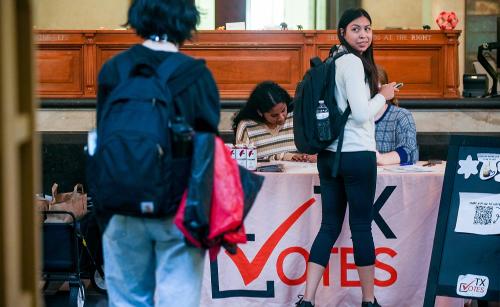The November 2024 election will be decided by a handful of states. The identity of the “swing” states, as they are called, changes somewhat over time for a variety of reasons. One of the newer additions to the swing states lineup is North Carolina. As the following table illustrates, at the beginning of the century, North Carolina was definitely not a swing state. George W. Bush won it twice by substantial margins. Then in 2008, Barack Obama, the first successful African American presidential candidate, eked out a victory that was widely attributed to very high African American turnout. However, even though Obama couldn’t repeat this victory in 2012, the Republican margins in subsequent elections never returned to the robust margins Republican candidates saw at the beginning of the century.
Something was changing in North Carolina.
Population growth and shifting demographics
When states change their political leanings, it is often due to changes in population. In North Carolina, the Raleigh-Durham-Cary combined statistical area has been a center of growth for the state. Since 2020 alone, this area has seen its population increase by 5.6%—making it the 10th fastest-growing area in the country. The presence of three large research universities and growth in the high-tech and life sciences industries has led to important shifts in the demographics of the state, all in a direction that looks more favorable to Democrats.
Drawn to these high-growth industries and areas, new North Carolinians have come from heavily Democratic states. Many are people of color and many have college degrees—all of which are correlated with Democratic voters. For example, from 2011 to 2021, the largest increases in net migration to North Carolina came from California, New York, and other New England states, followed by Virginia, Florida, and Texas. The first three areas are heavily Democratic in their voting patterns, and it is likely that many of these people will continue to vote Democratic in their new state. Among the 900,000+ people that moved to North Carolina between 2010 and 2020, almost 90% are people of color and they too are likely to bring their Democratic voting habits with them to their new state.
Most importantly, the percentage of North Carolinians with at least a bachelor’s degree is growing. According to a study by the University of North Carolina at Chapel Hill, “since 1990, the population of working-age adults with a bachelor’s degree or more in the state increased by 1.4 million—70% of whom were born outside of North Carolina.” This is especially significant given that one of the most important predictors of a Democratic voter these days is whether or not they are college educated.
Seeing the trends and leading the way
Understanding these trends is the first step towards taking advantage of them. As the youngest state Democratic Party chair in the country, Anderson Clayton is shaking up North Carolina politics. She believes voters can break the cycle of Democratic Party stagnation and help turn North Carolina blue in November. Central to the North Carolina Democratic Party’s 2024 electoral organizing strategy, spearheaded by Clayton, is mobilizing young voters and re-engaging rural communities. She hopes to tap into college campuses across the state to encourage young people to register to vote and recruit them as volunteers, aiming to help carry the Biden campaign over the finish line.
Clayton also understands the importance of down-ballot races. In 2022, Democrats left over 25% of state legislative races unchallenged—strengthening the North Carolina Republican Party’s stranglehold over legislative power. After Democratic state lawmaker Tricia Cotham announced she would be joining the GOP last April, Republicans gained a veto-proof supermajority in the state legislature. Since being elected, Clayton has set her sights on contesting every race in the state. Her efforts have been largely successful: After the close of the candidate filing period in December, Democrats had candidates in 168 out of the state’s 170 legislative districts.
Down-ballot momentum
Students of politics are familiar with the concept of “coattails” where a popular candidate at the top of the ticket—usually the presidential candidate—pulls in candidates lower down on the ballot. But momentum works in the other direction as well. For instance, in 2020, the momentum in the Georgia U.S. Senate races helped secure Biden a win in the state. Largely driven by high turnout from Black voters, the down-ballot momentum bubbled up to the top and contributed to him eking out a win in the Peach State.
Research by BlueLabs has shown that there is an “estimated 0.4%-2.3% bump in top-of-ticket vote share when every local state legislative seat within a precinct is challenged.” As noted above, in the 2024 elections, North Carolina Democrats are contesting nearly all state legislative seats. According to Heather Williams, President of the Democratic Legislative Campaign Committee, “The bottom of the ticket is absolutely driving engagement and will for all levels of the ballot.”
The other way that a down-ballot candidate can have a substantial effect on other races such as the presidential is for the candidate to be especially good or especially bad. In North Carolina, the Republican Party nominated a far-right candidate named Mark Robinson. The Republican gubernatorial nominee has a long history of incendiary comments. In Facebook posts that are still up today, Robinson has perpetuated racist, antisemitic, homophobic, and transphobic stereotypes. In some cases, his extremist viewpoints position him to the right of former President Donald Trump. Robinson has peddled conspiracy theories ranging from denying the Holocaust to entertaining the idea that the 1969 moon landing was fake. He has advocated for a complete abortion ban without exceptions, but now denies that he said this. As a result of his far-right views and inflammatory rhetoric, Robinson has struggled to garner support outside of his conservative evangelical base—alienating moderate voters and anti-Trump Republicans. Democrats hope that his extreme views on abortion will galvanize voters to go to the polls, resulting in a “reverse coattails” effect that will lift Biden to victory in the state.
It is no wonder that President Biden and Vice President Harris have been spending a lot of time in North Carolina lately. Although there are positive signs for the Democratic ticket, they still have challenges before them. In the recent North Carolina Democratic primary, almost 13% of people voted “No Preference” for president, tallying up to more than 88,000 votes. With Biden losing the state by 74,000 votes back in 2020, courting voters concerned about the crisis in Gaza—many of whom are young people and people of color—is critical. Nonetheless, a substantial amount of change has happened in North Carolina during the 21st century, which is why the 2024 battle for this swing state will be intense.
The Brookings Institution is committed to quality, independence, and impact.
We are supported by a diverse array of funders. In line with our values and policies, each Brookings publication represents the sole views of its author(s).









Commentary
North Carolina’s emergence as a swing state could help Biden win in November
May 9, 2024